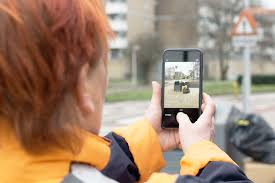With the information of the mailmen, the municipality wants to improve it’s internal processes in order to increase the satisfaction of citizens concerning the way the municipality solved the problem reported.
Kickoff municipality and PostNL
PostNL en gemeente samen voor een schoner Amsterdam | PostNL
Samenwerken aan een schoner Amsterdam | PostNL
What is the goal of the project?
The increased popularity of the city of Amsterdam puts extra pressure on keeping the city clean. Therefore, the municipality started a special ten-points program aiming to increase the properness of the city. A clean city is one of the basic conditions for a livable citiy.
The municipality of Amsterdam receives 200-300 reports on the public spaces from citizens every day. Citizens report places where the municipality should take action in order to keep the streets clean. The municipality sends employees to those places in order to clean.
However, 39% of the citizens who reported an issue, is not satisfied with the way the municipality dealt with the report.
Therefore, the municipality has asked the mailmen of PostNL to check the actual status on the street after the employee of the municipality confirmed that het executed the task at the location.
Next to this ‘fact checking’ on the street, mailmen will also be asked to report places where the municipality should take action to clean the street. Finally, mailmen will take surveys at people’s doorstep (randomly selected addresses) to ask the opinion of citizens and ask how the municipality and the citizens could improve their actions in order to keep Amsterdam a clean, livable and attractive city.
What is the result of the project?
With the information of the mailmen, the municipality wants to improve it’s internal processes in order to increase the satisfaction of citizens concerning the way the municipality solved the problem reported.
Goals of the municipality
- To what extent can we ask the mailmen to check the actual status of a report in the public space?
- What can we learn from the results of the activities of the mailmen?
- Is the mailman able to take small surveys at people’s doorstep?
- How does this survey-information relate to the standard survey the municipality held under citizens every two years? What can the municipality learn from the results of the interviews?
- How do citizens evaluate the extra activities done by the mailmen?
Goals of PostNL
- To what extent can we ask the mailmen to check the actual status of a report in the public space?
- How do the municipality, citizens and the mailmen evaluate the project?
- To what extent can we help the municipality of Amsterdam to increase the livelihood of the city by collecting data on the public space using our mailmen and their smart devices?
Who initiated the project and which organizations are involved?
PostNL and the municipality jointly initiated the project. Next to PostNL and the municipality, several organizations are involved (e.g. CROW and NederlandSchoon as sparring partners, TauwBV and Verbeterdebuurt.nl as co-creation partners).
What is the next step?
We started in May 2017 with a small group of mailmen. During 2017, we scale up to six areas in Amsterdam, with in total approximately 180 – 220 mailmen in Amsterdam:
o Noord-West
o Osdorp
o Slotervaart
o Pijp / Rivierenbuurt
o Centrum West
o Oud Noord
What can other cities learn from your project?
Using the local presence of the mailmen on the street can deliver a broad variety of relevant information for policy makers and for companies cleaning the City. In this early stage of development, commitment of the management of PostNL as well as commitment of managers and de aldermen of the municipality of Amsterdam has been a crucial factor for success. Also, the close co-creation process of the municipality and PostNL has been a key factor for success.





